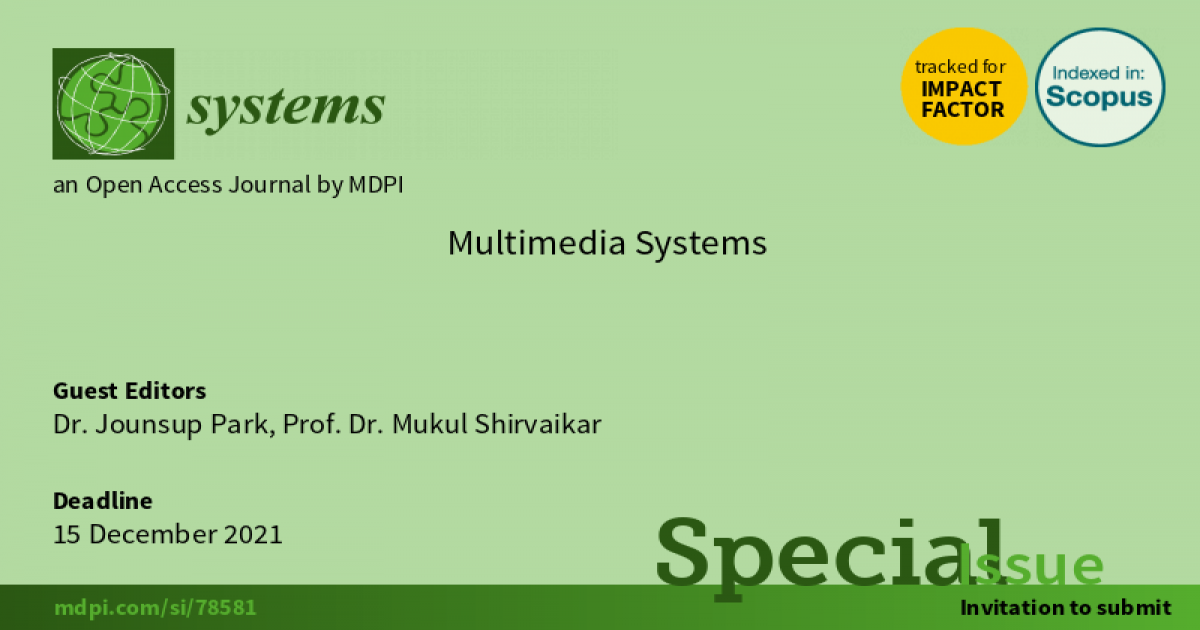Multimedia Systems
A special issue of Systems (ISSN 2079-8954).
Deadline for manuscript submissions: closed (15 December 2021) | Viewed by 14620

Special Issue Editors
Interests: multimedia networking; wireless communication; AR/VR; quality of experience; holo-presence; radar signal processing; network security; low latency network; AI; machine learning
Special Issues, Collections and Topics in MDPI journals
Interests: real time systems; image and signal processing; robotics and computer vision; system-on-a-chip design; pattern recognition; neural networks; medical imaging; engineering education
Special Issues, Collections and Topics in MDPI journals
Special Issue Information
Dear Colleagues,
This Special Issue of Systems invites you to discuss new ideas about design and optimization of multimedia systems.
Multimedia including text, images, audio, and video have a huge impact on our daily life. People read texts, watch videos, and listen to audio to receive information. The pandemic we are currently experiencing worldwide has increased the importance of interactive multimedia systems even more, as people work remotely using video conferencing systems and students learn using online education systems. Telemedicine helps both to protect health care providers and to provide remote healthcare services to patients. Virtual reality (VR) and augmented reality (AR) technologies are expected to enable more realistic multimedia services. However, designing multimedia systems is not easy. Multimedia systems consist of many components, such as sensors, networks, processing and storage devices, and display devices. These components work together to provide a multimedia experience to the users. Moreover, it is difficult to measure the quality of multimedia services, since quality can differ depending on their applications. Accurate measurement of the quality of multimedia services, however, is important to optimize the system.
We are calling for contributions to multimedia system designs including VR/AR applications and quality metrics of the system. Topics of interest include:
- Multimedia system and its applications;
- Multimedia system performance evaluation;
- Multimedia system performance metrics;
- Multimedia system design;
- Multimedia systems for education;
- Multimedia systems for telemedicine;
- Optimization of multimedia systems;
- Machine learning (ML) and Artificial Intelligence (AI) for multimedia systems.
Prof. Dr. Mukul Shirvaikar
Dr. Jounsup Park
Guest Editors
Manuscript Submission Information
Manuscripts should be submitted online at www.mdpi.com by registering and logging in to this website. Once you are registered, click here to go to the submission form. Manuscripts can be submitted until the deadline. All submissions that pass pre-check are peer-reviewed. Accepted papers will be published continuously in the journal (as soon as accepted) and will be listed together on the special issue website. Research articles, review articles as well as short communications are invited. For planned papers, a title and short abstract (about 250 words) can be sent to the Editorial Office for assessment.
Submitted manuscripts should not have been published previously, nor be under consideration for publication elsewhere (except conference proceedings papers). All manuscripts are thoroughly refereed through a single-blind peer-review process. A guide for authors and other relevant information for submission of manuscripts is available on the Instructions for Authors page. Systems is an international peer-reviewed open access monthly journal published by MDPI.
Please visit the Instructions for Authors page before submitting a manuscript. The Article Processing Charge (APC) for publication in this open access journal is 2400 CHF (Swiss Francs). Submitted papers should be well formatted and use good English. Authors may use MDPI's English editing service prior to publication or during author revisions.
Benefits of Publishing in a Special Issue
- Ease of navigation: Grouping papers by topic helps scholars navigate broad scope journals more efficiently.
- Greater discoverability: Special Issues support the reach and impact of scientific research. Articles in Special Issues are more discoverable and cited more frequently.
- Expansion of research network: Special Issues facilitate connections among authors, fostering scientific collaborations.
- External promotion: Articles in Special Issues are often promoted through the journal's social media, increasing their visibility.
- Reprint: MDPI Books provides the opportunity to republish successful Special Issues in book format, both online and in print.
Further information on MDPI's Special Issue policies can be found here.






